Rick's b.log - entry 2016/03/13 |
| ||||||
mailto: blog -at- heyrick -dot- eu
You are not reading my b.log using HTTPS. You can switch to HTTPS by clicking here. Feeling my ageYesterday, the 12th, was Mom's birthday. So we decided to go "Down South". South, in this case, is specifically a town called Clisson. A town in the area of the vignoble (that means wine growing area) with Italian style architecture.It is also the location of HellFest - not that you'd know it: 
After doing some shopping at a very nice supermarket (that puts the ones around here to shame), we went a little off the beaten track towards a town called Le Pallet, where we stopped to look at a medieval church and dungeon (there wasn't much of either left). Just beyond the giant wooden crucifix monument, the ground dropped off sharply: 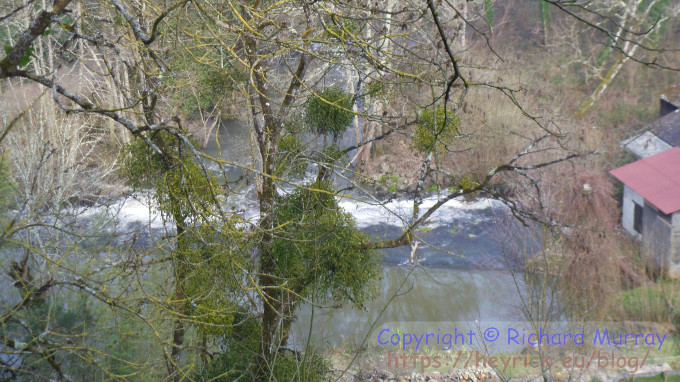 Mom didn't want to go down so I said "a hundred and eighty seconds", as in I'll just pop down, get some photos, then come back. Going down was, obviously, fairly easy. At the bottom was a dinky wooden bridge, with a calm river (the Sanguèze) on one side of the bridge, and "rapids" on the other: 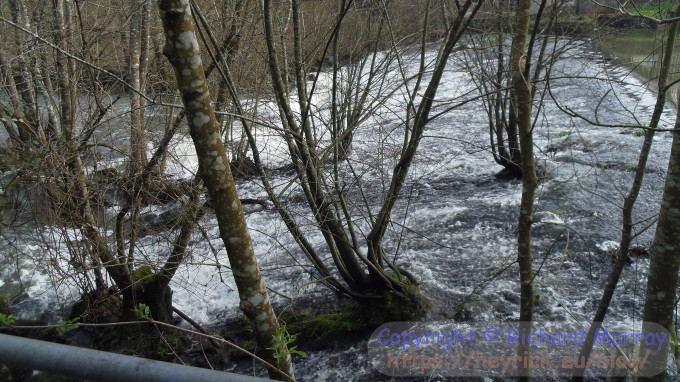
I got a few photos, and the count was ninety seconds, which gave me a minute and a half to get back. 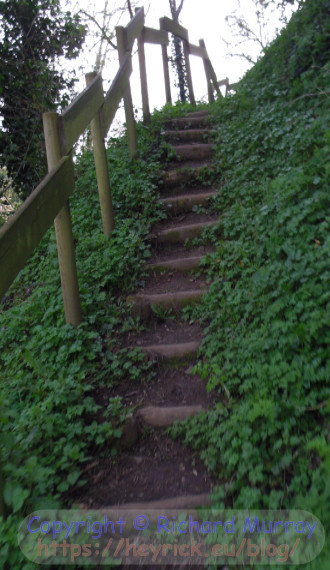 I made it. One seventy six. But I felt like my legs were going to give up working and I was breathing so heavily I'm surprised my heart didn't give up. When I first came to France (a billion years ago), going up there would be a "no sweat" kind of deal. This time, I needed several minutes recovery time at the top. I think this is the first time I can say I really felt my age. Damn. Next time we'll take a walk slowly.
The smart weather stationIt was a nice Sunday. That usually means one thing - a vide grenier. Yup. The season is starting again. And a tenner got me a LaCrosse Technology WS2300 weather station. I'd wanted one of these for a while. The unit builds upon the usual wall-mounted weather stations by providing a wind speed/direction sensor and a pluviometer (rain sensor) in addition to the usual outdoor temperature/humidity sensor.The equipment comes with ten metres of cable for each of the wind and rain sensors (they plug into the outdoor temperature sensor) and then an optional 10 metre cable to connect the outdoor sensor to the display unit. This is the preferred way to run the system as the display unit can be plugged into a little power pack and when used like that, the display unit will power the sensors so the batteries will be used just for backup in case of power cuts.
Unfortunately there are no locations that are really suitable for mounting the wind sensor. I guess the ideal position would be on the chimney, but good luck if you think it'd be easy getting up there. So I have set the system up temporarily in the garden and am using the 433MHz transmitter. I didn't want to use radio transmission as thick stone walls tend to be something of an impediment, but there's no choice at the moment. Here's the wind sensor mounted 'rustic': 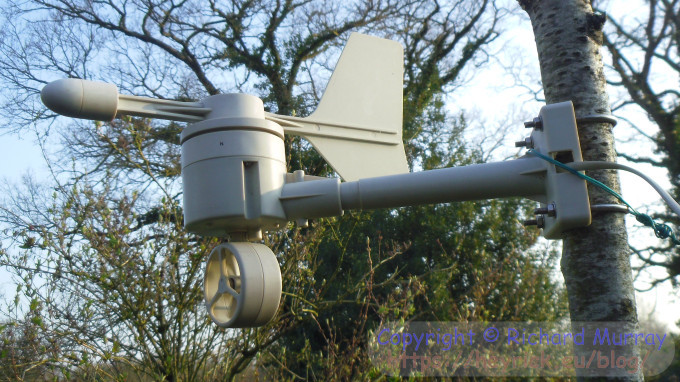 Note that it is mounted flat (kind of needs to be!), the photo is slightly skewed... If you think that's bad, here's the rain sensor: 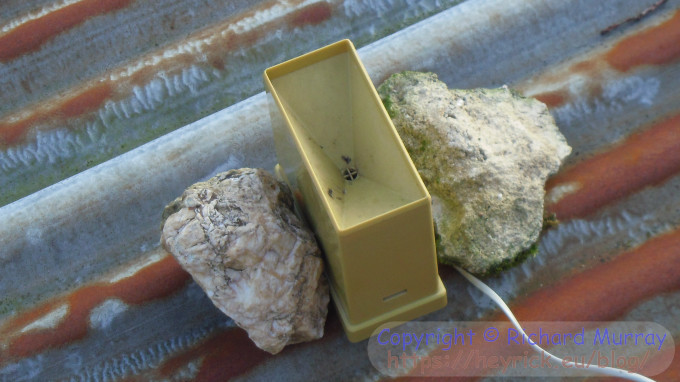 Both of these plug into the temperature/humidity sensor: 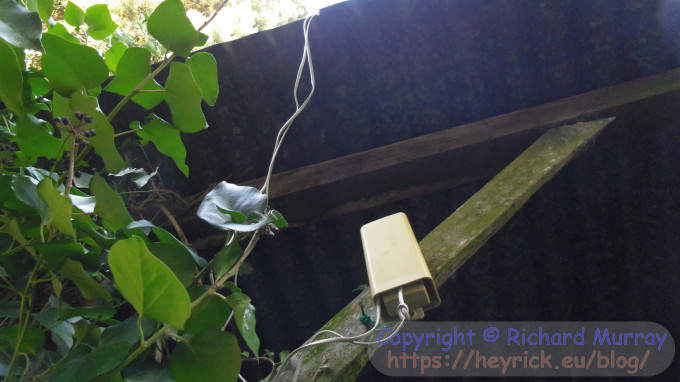 This should be connected to the display unit, but in the absence of practical ways of making that work, it transmits at 433MHz to the display unit: 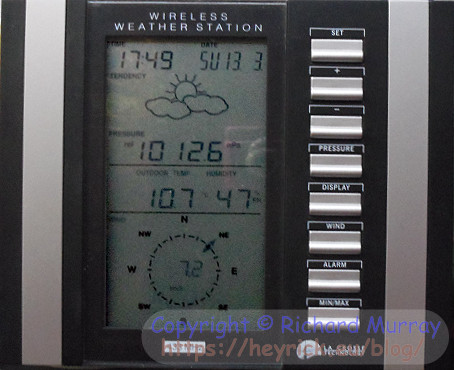 The second part of the display is for temperature and humidity. 10.7°C and 47% humidity is the external reading. The Display button will select between internal and external readings. As I'm interested in whether or not I need to keep an eye on the (well water) pump, this will likely read external all the time. The bottom of the display shows wind direction and speed. Shown is a NE wind at 7.2kph. It is possible to configure all sorts of options (kph, mph, m/sec, beaufort...). Pressing the Wind button switches between wind angle in degrees, wind direction (as in "ENE"), and wind speed. The Alarm button is because you can set up all sorts of alarms to go off when things are below or above a minimum or maximum threshold. I've set an alarm to sound if the temperature goes below -1.5°C, though with the device in the living room at the moment, I'm not sure I'll hear it!
Now one of the things that really bugged me about other weather devices is that the remote sensor picks a 'random' code for itself when batteries are inserted. This means that the base unit invariably needs to be reset in order to be able to pick up the transmitter again. It is stupid to have to reset the base (and lose min/max, settings, etc) just to change the batteries in the outdoor sensor. Now so with the WS2300. Simply hold the + button for a couple of seconds and it will sync into the sensor again. This is a big plus for this unit. Then comes the part nerds will like. There's a serial port.
Included in the box was a USB to proper serial interface (as I don't actually have one - my USB-serial interface is 3.3V serial with Tx/Rx only for debugging on the Pi). The interface was usefully based upon the Prolific chipset (I don't know if it is real or clone as it is a sealed plug, I'm guessing real as it looks a better quality than the usual Chinese clones). Useful, too, as I refuse to run any FTDI (real or otherwise) in respect to FTDI's choice of intentionally damaging clone devices. Refusing to work with them is acceptable. Actually messing with them is a step too far. That was the simple part. The software is of the Windows 98 era, but amazingly it is still available on-line, at heavyweather.info, so I could download and install it. That was simple as well.
What wasn't so simple is that it crashed on XP. I set the compatibility to Windows 98/ME, but it still crashed (error 0x00000005). The error tipped me off. The "0x" prefix made me think that the program is likely written in C, and the '5' suggests to me that it was a SIGSEGV error, a bad memory access.
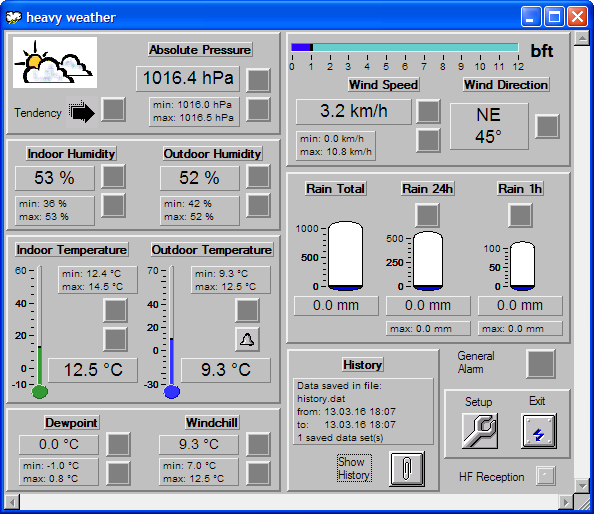
The software takes a good few seconds to populate the display, so I'm guessing we're running at some treacle-slow data rate, like 1200 or 2400bps. It's a shame that I can't determine the capabilities of the microcontroller inside the WS3200. I know there's no point taking it apart because firstly any messing with the LCD runs the risk of missing segments (I've taken apart enough calculators to know that touching the display and its contact strip in any way is a really bad idea), and if I get to the chip (depending on where it is inside), it will either be a custom part, or the information will be removed, or the whole thing buried in a splodge of hard epoxy.
Your comments:Please note that while I check this page every so often, I am not able to control what users write; therefore I disclaim all liability for unpleasant and/or infringing and/or defamatory material. Undesired content will be removed as soon as it is noticed. By leaving a comment, you agree not to post material that is illegal or in bad taste, and you should be aware that the time and your IP address are both recorded, should it be necessary to find out who you are. Oh, and don't bother trying to inline HTML. I'm not that stupid! ☺ ADDING COMMENTS DOES NOT WORK IF READING TRANSLATED VERSIONS.
|
(Felicity? Marte? Find out!)
📺 The SIBA stories 📹
It's a simple substring match.
Last read at 12:50 on 2024/04/25.
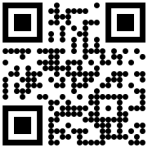

| |||||||
| Next entry - 2016/03/19 Return to top of page |
| © 2016 Rick Murray |
| Retrieved from http://www.heyrick.co.uk/blog/index.php?diary=20160313 on 25th April 2024 |


